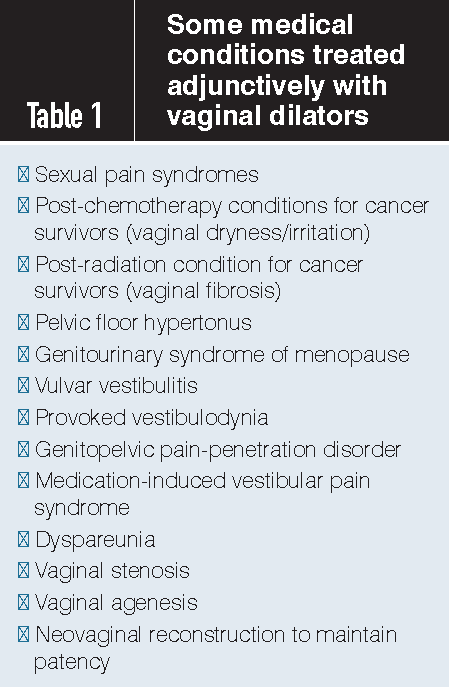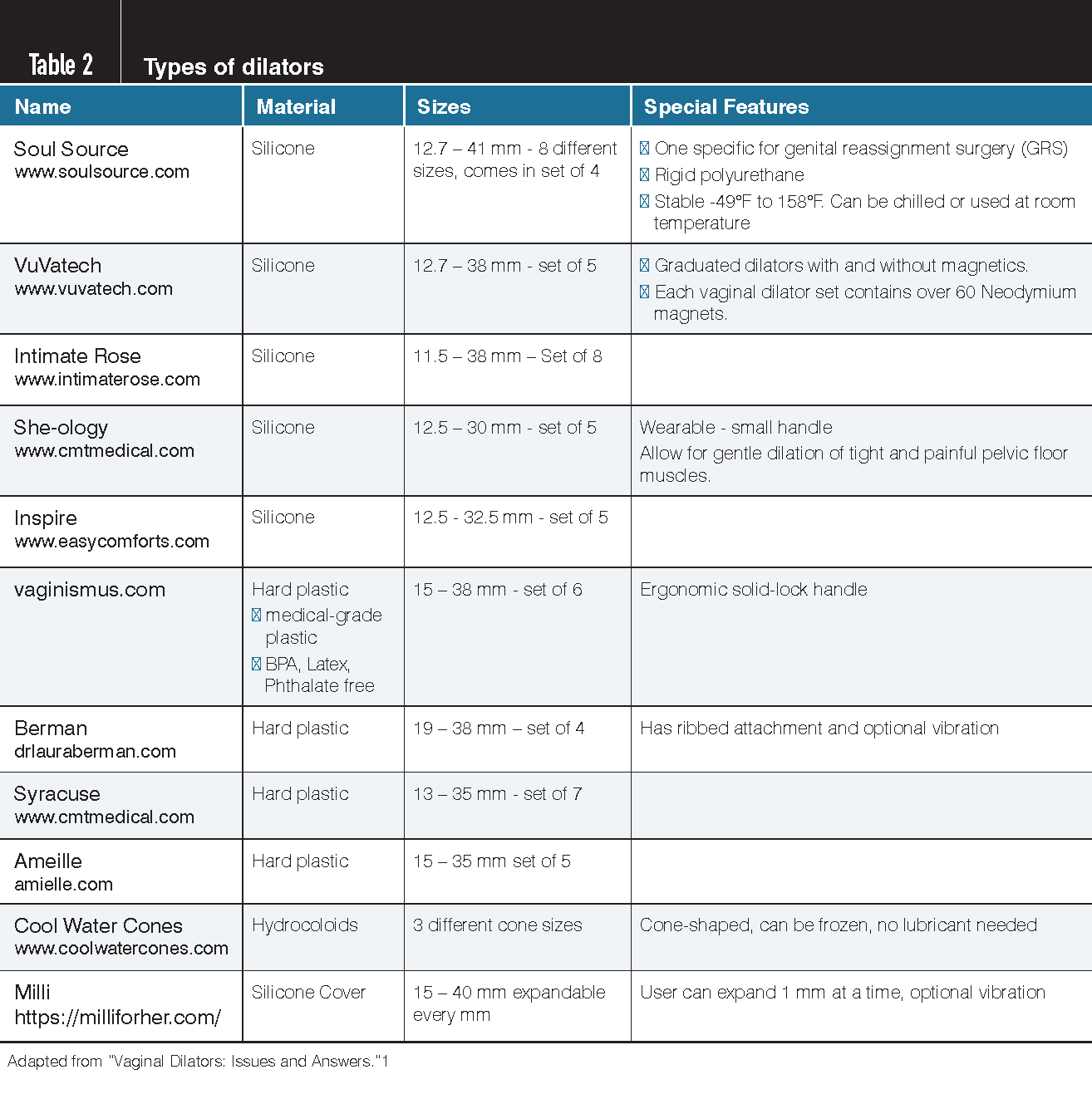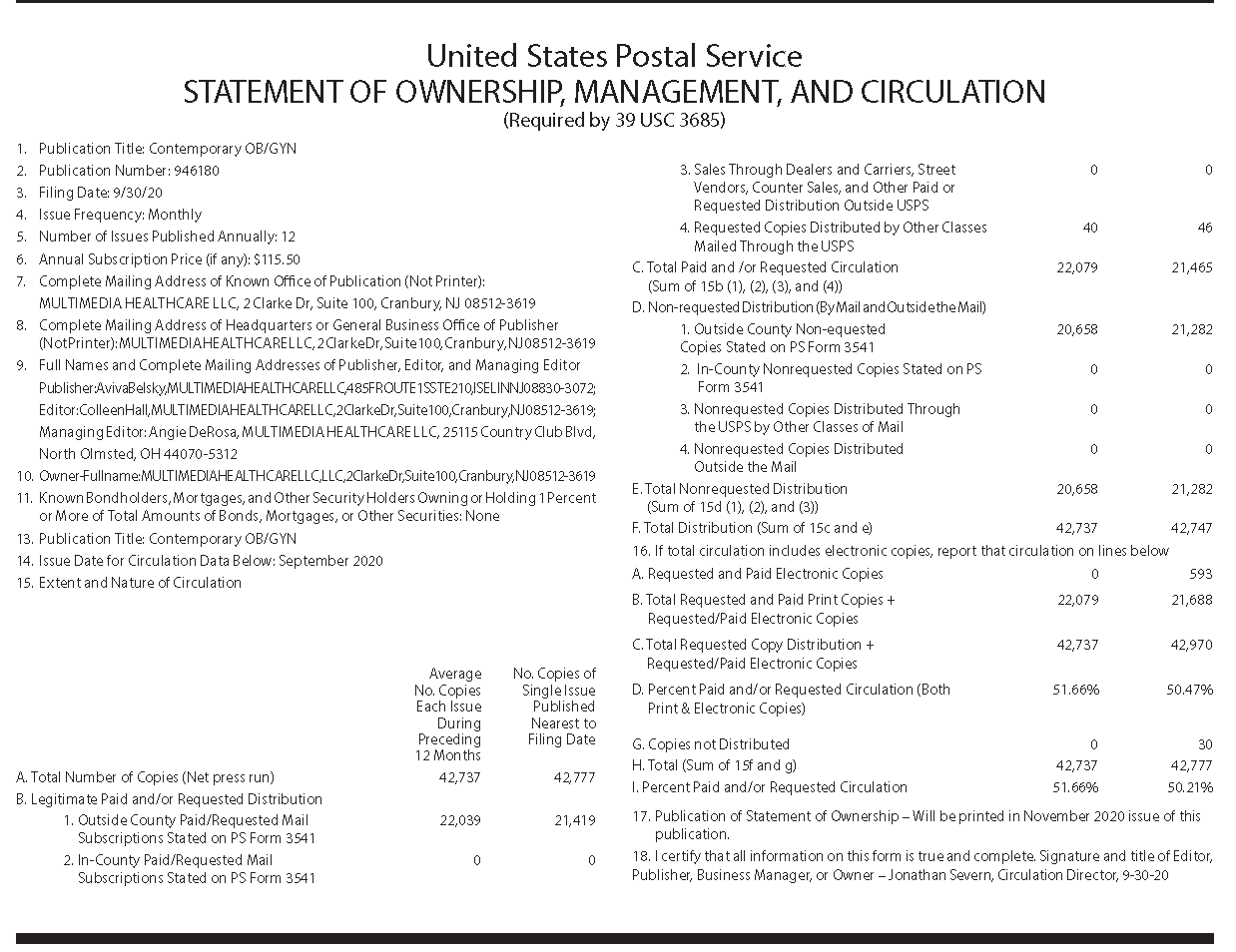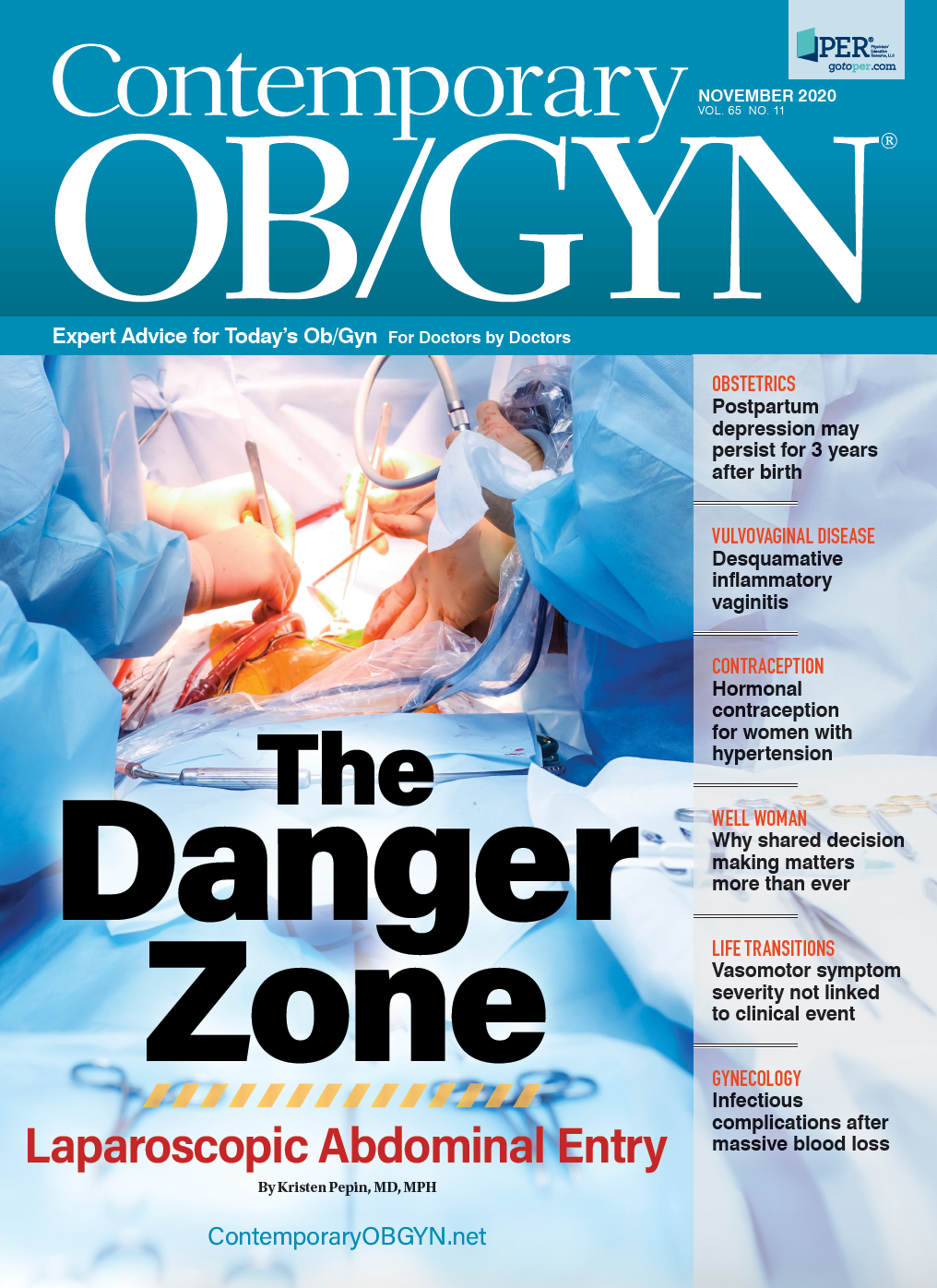Vaginal Dilators: A guide for health care professionals
Peer-reviewed
These therapeutic medical devices can be used by patients to effectively treat pelvic pain and anxiety related to intercourse.
Vaginal dilators are an effective medical treatment for women experiencing pelvic pain and pain during intercourse and have demonstrated clinical success for over 75 years.
These devices (alternately known as vaginal trainers) are inserts of progressive diameter used to stretch the vagina, decrease pain, and reduce anxiety related to intercourse (Table 1).
Table 1

Dilators are prescribed by a diversity of medical health care professionals, including ob/gyns, pain specialists, pelvic floor physical therapists, nurse practitioners, counselors, and psychologists. Vaginal dilation also is standard of care for treatment of postoperative male-to-female transgender patients who wish to maintain the patency of the neovagina.
Proper usage is thought to recondition and facilitate an adaptive body/brain connection to eliminate anticipatory anxiety and pelvic discomfort or pain that women often experience in anticipation of intercourse.
Barriers to dilator use
According to a survey of 239 dilator users, 56.8% of women had suffered for more than 2 years, and 52% had seen more than 3 clinicians before they began dilator therapy.1 A major hindrance to timely care is patient apprehension about discussing intimate issues with anyone, including their medical professional.
Health care professionals are often remiss in discussing sexual pain syndromes, and such problems often go unaddressed at the clinical visit.
Additional barriers to effective assessment include poor communication skills, time constraints, and reimbursement considerations. Many women being treated with vaginal dilators have self-diagnosed their condition and sought over-the-counter treatments.
Watch: Vaginal dilators with Michael Krychman, MD
Liu et al published a survey by one manufacturer showing that 70% of women who purchased their dilation device used it without direct guidance from a clinician.1 Some information on self-directed treatment of pelvic pain conditions is available directly to consumers in online blogs, message boards, and video-sharing sites.
In addition, dilators may play a role in sexual pleasure, and some women report improved sensuality and sexuality after use. Minimal published scientific data are available concerning dilator use. Studies are lacking on evaluation of optimal treatment protocols, but a brief report about current dilator usage is appropriate for ob/gyns.
Summary of published data
Liu et al1 summarized recently published dilator research in a review article, “Vaginal Dilators: Issues and Answers” in the scientific journal Sexual Medicine Reviews and noted that the most frequently published data describe treatment of postmenopausal women who also have a diagnosis of genitourinary syndrome of menopause and or dyspareunia.
Several studies also show high rates of dyspareunia in breast, gynecological, and colorectal cancer survivors, especially among those who have received brachytherapy in the pelvic region. These studies show that many of these patients can benefit from dilator use in sexual rehabilitation. However,optimal protocols for dilator use frequency and duration of dilator sessions remain to be determined and confirmed inscientific literature.2
Dilator characteristics
Vaginal dilators have historically been cylindrical medical devices that sequentially increase in diameter and or length. They are placed within the vagina to help expand vaginal tissues that may be contracted due to vaginal atrophy, increased pelvic muscular spasm, or exogenous fibrotic damage due to chemotherapy or brachytherapy.
By therapeutically stretching tight fibrotic tissues, these devices facilitate relaxation of the vaginal lining.3 Ultimately, consistent use of dilators may help a patient reclaim pelvic floor relaxation and provide a method of behavioral modification.4 Often referred to as vaginal trainers, dilators remain an integral part of the overall medical treatment plan for a wide variety of genito-pelvic medical conditions.
Table 2

They may be made from materials including but not limited to medical grade plastic, latex, glass, and silicone. They may also have special additive features (Table 2). Head-to-head clinical studies comparing different types of dilators have not been completed.
Factors that influence health care professional dilator choice include ease of patient use, affordability, material, and durability.
Incorporating dilators into the treatment paradigm
Compliance with dilator use remains low, and some studies report adherence rates below 25%.3 Poorly defined intervals, limited dilator sizes, and difficulty with progressing from one size to another remain challenging obstacles.5 Oelschlager et al6 discussed vaginal dilator therapy in patients with vaginal agenesis and reported a comprehensive treatment paradigm.
Patient readiness for dilation and high patient motivation for dilation are predictive of compliance and success. In addition, the authors outlined a comprehensive plan for patient education and instruction concerning dilators: Patients should be advised to void before dilating, lay in a semi-recumbent position and use the devices with lubricant and/or topical lidocaine ointment if they experience pain.
Health care professionals should confirm that patients have an awareness and understanding of their own pelvic and vaginal anatomy. More frequent dilation (2 to 4 times per day) was reported as a variable linked to a higher rate of anatomic success compared to dilation only once daily. Henceforth, the authors encourage patients to dilate as frequently as possible.
Alternately, in the launch data from the Milli™ dilator survey, patients who dilated between 15 to 20 minutes reported the greatest reductions in anxiety and pain. It appeared that 15 to 20 minutes was the optimal dilation duration for success.
In addition, activities that seemed to distract the patient, including television watching, deep breathing, or relaxation techniques, were associated with large reductions in pain and anxiety.1
Patients who were encouraged to use their dilators before coitus had reduction in pain and anxiety.
Although there is no current consensus in the field, many sexual medicine experts recommend that their patients dilate at minimum 3 times a week for no longer than 10 to 15 minutes per session to prevent patient/dilator burnout. Best practices include provision of detailed dilator instructions regarding position, interval, and duration of use, followed by close surveillance and frequent follow-up visits with the health care professional.
A multidisciplinary approach to the management of these complex gynecological problems is often best served with a multimodal treatment paradigm, including cognitive behavioral therapy, mindfulness, biofeedback, rhythmic breathing, vaginal and systemic medications, and training to decrease anticipatory anxiety. Genito-pelvic floor physical therapists are an important and integral component of the treatment schema and should be actively involved in the treatment plan.7
Conclusion
Dilators are an important, adjunctive mode of treatment for women with pelvic or sexual pain syndromes. They continue to be underutilized and under-prescribed.
Future research should focus on optimal frequency and duration of dilation sessions needed to achieve the desired clinical outcome, while minimizing patient noncompliance. Comparative studies with validated outcome measures comparing dilators of varying materials should be conducted.
Such research will help physicians guide their patients toward effective, evidence-based dilator therapy to help mitigate anticipatory anxiety with painful intercourse and accelerate return to coitus.
__
About the Authors
DR. KRYCHMAN is a gynecologist who specializes in sexual health and survivorship medicine. He is executive director of the Southern California Center for Sexual Health and Survivorship Medicine Inc. in Newport Beach, Calif.
DR. LIU is a gynecologist at the University of California, Irvine.
DANIEL MELLER is a fourth-year medical student at the University of California, Irvine.
__
Statement of Ownership

__
References
- Liu M, Juravic M, Mazza G, Krychman ML. Vaginal Dilators: Issues and Answers Sex Med Rev. 2020;S2050-0521(19)30125-8. doi:10.1016/j.sxmr.2019.11.005
- Melnik T, Hawton K, McGuire H. Interventions for vaginismus. Cochrane Database Syst Rev. 2012;12.
- Lee Y. Patients' perception and adherence to vaginal dilator therapy: a systematic review and synthesis employing symbolic interactionism. Patient Prefer Adherence. 2018;12:551-560.
- Idama O, Pring T DW. Vaginal dilator therapy: an outpatient gynaecological option in the management of dyspareunia. J Obstet Gynaecol. 2000; 20:303-305.
- Macey K, Gregory A, Nunns D, et al. Women's experiences of using vaginal trainers (dilators) to treat vaginal penetration difficulties diagnosed as vaginismus: a qualitative interview study. BMC Womens Health. 2015;15:49.
- Oelschlager A, Debiec K. Vaginal dilator therapy: a guide for providers for assessing
- readiness and supporting patients through the process. J Pediatr Adolesc Gynecol. 2019;32: 354e358.
- Conforti C., Genitopelvic pain penetration disorder (gppd) an overview of current terminology, etiology and treatment. Univ Ottawa J Med. 2017;7:48-53.

FDA approves Visby’s test for at-home STI identification
Published: March 28th 2025 | Updated: March 28th 2025The FDA has approved Visby Medical’s at-home sexually transmitted infection test, allowing women to screen for chlamydia, gonorrhea, and trichomoniasis without a prescription.
Read More
In this episode of Pap Talk, Gloria Bachmann, MD, MSc, breaks down what it means to be a health care provider for incarcerated individuals, and explores the specific challenges women and their providers face during and after incarceration. Joined by sexual health expert Michael Krychman, MD, Bachmann also discusses trauma-informed care and how providers can get informed.
Listen
